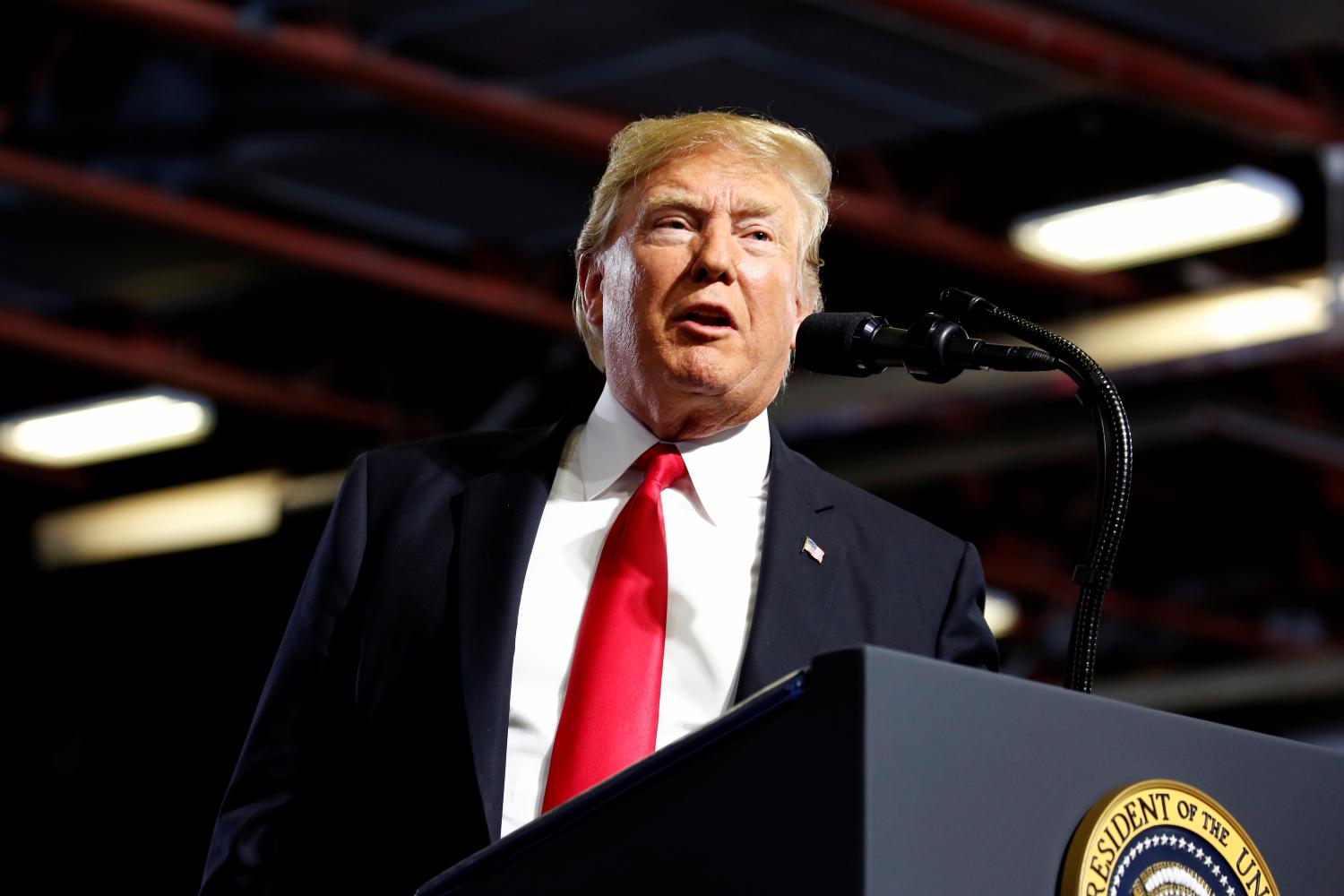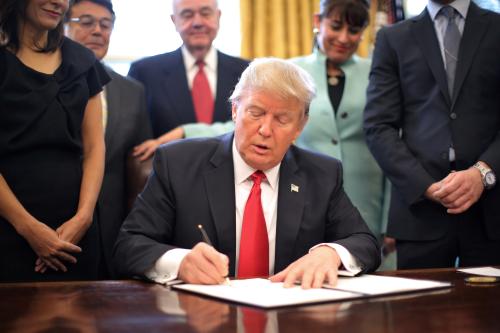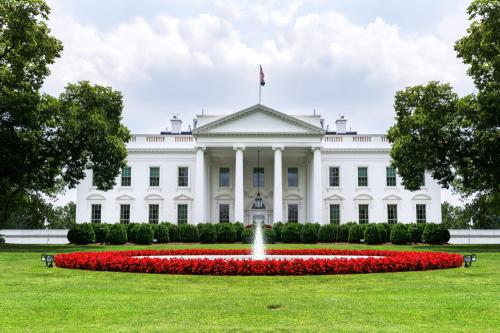This report is part of the Series on Regulatory Process and Perspective and was produced by the Brookings Center on Regulation and Markets.
While talk of whether Trump is or is not “draining the swamp” of lobbyists continues in Washington (and on Twitter), one form of lobbying—lobbying the White House about regulations—has quietly flown under the radar. The Office of Information and Regulatory Affairs (OIRA)—the tiny White House office that serves as a clearinghouse for agency rules—regularly holds private meetings with stakeholders about regulations that are under development. These meetings are referred to by the anodyne-sounding term “12866 meetings” (in reference to Executive Order 12866, which governs regulatory review), but make no mistake about it—these meetings are regulatory lobbying pure and simple.
The stylized view of lobbying evokes smoke-filled rooms, deal-making, and longstanding relationships. Lobbying OIRA is different for at least three reasons. First, OIRA provides oversight in the rulemaking process, ensuring that draft agency regulations are congruent with the administration’s priorities, represent good public policy, and are analytically sound. As such, the office has an open door policy, meaning that they will take a meeting with any stakeholder who requests it, so long as the meeting pertains to a rule that is formally under OIRA review. Second, regulatory lobbying is necessarily narrowly focused on a specific rule, rather than a broader issue. Third, 12866 meetings do not involve a give-and-take between OIRA officials and lobbyists; rather government participants behave as passive listeners and do not volunteer information or reveal details about the rule under development.
Typically, a group that meets with OIRA will also submit a public comment to the agency about the rule in question. The 12866 meeting, then, serves as a way to amplify the group’s comment; in essence, the group is appealing to a higher authority—OIRA— to ensure that their policy concerns are being taken seriously. This means that 12866 meetings are often concentrated on issues where the requesting group believes that the agency’s rule is likely to impact their interests (often negatively) and where the group has reason to believe the sponsoring agency is unlikely to respond to their concerns without additional pressure. For instance, when Trump’s Environmental Protection Agency proposed to roll back the Clean Power Plan, the Natural Resources Defense Council met with OIRA and provided information challenging some of the technical assumptions the agency adopted in its regulatory analysis. Put simply, lobbying OIRA is one way for groups to “pull out all the stops” in an effort to get desirable regulatory policies.
While 12866 meetings are not open to the public, there is still considerable transparency surrounding them. OIRA discloses not only when they took place, but who attended, and also posts any materials given to them by the lobbying entity.1 This transparency has allowed researchers to gain some insight into their impact. According to the Center for Progressive Reform, experienced groups with the money and know-how to navigate the rulemaking process account for the majority of meetings. And recent research by political scientists suggests that these meetings can be influential in terms of convincing OIRA to make favorable changes to the rules under review, particularly when businesses are the ones doing the lobbying. While former OIRA Administrator Cass Sunstein contends that these meetings do not influence OIRA’s decision-making, the sheer number of them suggests that lobbying groups view them as valuable.
How has regulatory lobbying fared in the Trump era? In order to answer this question, I collected data on 12866 meetings held in Trump’s first year. For reference, I compared these data with meetings held in Obama’s first year. The first year of a president’s term is a useful point to study the presidency; in this timeframe, a new president lays out regulatory goals—possibly ambitious ones as Trump has done—and sets the tone for the remainder of their time in office. What I found is that regulatory lobbying in the Trump era departs from the patterns observed under Obama in important ways, although not necessarily ones that popular perceptions of the two administrations would predict. Below, I highlight four points about regulatory lobbying in Trump’s first year.
1. Regulatory lobbying continued to increase in Trump’s first year
As regulation has become a hot-button issue in recent years, regulatory lobbying has been on the rise. For example, in 2003 (the third year of George W. Bush’s administration), OIRA held an average of 1.8 meetings with lobbyists per week; by 2011 (the third year of Obama’s administration), that figure had jumped to 4.8. Keeping in mind that lobbying meetings tend to be lowest in a president’s first year, Trump’s pattern represents a continuation of this ongoing trend. Compared to Obama’s first year, meetings went from an average of 2.2 per week to 3.9 per week under Trump, an increase of about 80 percent.
Lobbying growth under Trump breaks from prior patterns in an important way, however.
As shown in Figure 1, the increase under Trump occurred despite a notable decline in the volume of proposed and final rules reviewed by OIRA in his first year.2 While the figure focuses on “significant” rules (i.e., only those that OIRA selects for review), the pattern persists if one considers the broader set of rules published in the Federal Register (i.e., all proposed or all final rules). In other words, despite fewer rules being issued under Trump’s watch, there were more meetings. While data limitations prevent a comparison of 12866 meetings between the administrations of Trump and George W. Bush,3 Trump also issued fewer significant proposed and final rules than did Bush in the first year. At a minimum this suggests that there is not a clear partisan factor driving Trump’s regulatory approach.
Although lobbying meetings increased, it does not appear that Trump’s OIRA necessarily gave them greater priority. OIRA’s 12866 reports indicate not just that a meeting occurred, but also who attended the meeting. Meetings tend to be large—the average number of attendees for the meetings I studied was 12 people. They typically include representatives of the organization that requested the meeting, as well as representatives of the agency that sponsored the rule, officials from the Office of Management and Budget (OMB, under whose organizational umbrella OIRA is housed), and, occasionally, representatives from other units in the Executive of the President (EOP, which includes the Domestic Policy Council, the National Economic Council, Office of the Vice President, etc.). The number of OMB and other EOP officials that attend these meetings can be used to gauge how much attention the White House gives to these meetings. An average 12866 meeting under Obama featured four OMB participants and 0.5 EOP participants; under Trump the number of average attendees shrank to three OMB participants and 0.25 EOP participants.4 This patterns holds irrespective of the type of entity requesting the meeting (e.g., a business or public interest group). This decline in White House attention makes sense given that there were more meetings in total for OMB and Trump officials to split their attention over, while the number of OMB and OIRA officials remained relatively constant. But it also suggests that the administration was not necessarily granting increased priority to regulatory lobbying.
2. A handful of agencies accounted for majority of meetings
As Table 1 shows, much of Trump’s increased meeting activity was concentrated at three agencies: the Environmental Protection Agency, the Department of Health and Human Services, and the Department of Labor. While the EPA has historically been a centerpiece of regulatory lobbying, the other two agencies were not prominent lobbying targets in Obama’s first year.
| Table 1. 12866 meetings by agency, in Obama and Trump’s first years | |||
|---|---|---|---|
| Agency | Obama | Trump | Difference |
| Department of Agriculture | 14 | 5 | -9 |
| Department of Commerce | 0 | 7 | +7 |
| Department of Defense | 4 | 1 | -3 |
| Department of Energy | 1 | 0 | -1 |
| Department of Health & Human Services | 15 | 53 | +38 |
| Department of Homeland Security | 2 | 1 | -1 |
| Department of Housing & Urban Development | 1 | 0 | -1 |
| Department of the Interior | 1 | 8 | +7 |
| Department of Labor | 2 | 31 | +29 |
| Department of Transportation | 8 | 0 | -8 |
| Department of Treasury | 0 | 4 | +4 |
| Department of Veterans Affairs | 1 | 0 | -1 |
| Small Business Administration | 1 | 0 | -1 |
| Equal Employment Opportunity Commission | 1 | 0 | -1 |
| Environmental Protection Agency | 62 | 94 | +32 |
What accounts for the upswing at these agencies? One obvious answer is that all three feature prominently in Trump’s deregulatory agenda and issued rules that rescinded existing regulations or delayed newer ones from taking effect. For example, when the Trump administration planned to postpone the implementation date of the Department of Labor’s fiduciary rule (developed under Obama), OIRA hosted no fewer than 15 12866 meetings—11 at the proposed rule stage and four later on at the final rule stage. Similarly, the EPA’s review of the aforementioned Clean Power Plan gave rise to 12 meetings. And when the Department of Health and Human Services proposed to extend the compliance date for new nutrition labels for packaged foods, interests on opposing sides of the issue—the Center for Science in the Public Interest and SNAC, the international trade association for the snack industry—both wanted to meet with OIRA.
3. Interest groups—not industry—drove the increase
Lobbying is often associated with big business and industry. During Obama’s first year, these types of interests—that is, individual businesses and trade associations—dominated OIRA’s meeting lineup. As shown in Figures 2 and 3, these groups continued to make up the majority of meetings in Trump’s administration, but the mix of groups meaningfully shifted. Nonprofit groups that focus on the public interest (e.g., Public Citizen) or are more narrowly issued focused (e.g., Earthjustice) made up a greater proportion of the meetings.
Since 12866 meetings reflect the rules on the docket, what kinds of rules were these nonprofit groups responding to? Focusing on those meetings about rules that were deregulatory (i.e., those that explicitly dealt with rescissions or implementation delays), nonprofit groups dominated, holding 1.2 meetings for every one held by a business or industry group. Put simply, much of the surge in nonprofit lobbying was a direct response to the administration’s deregulatory agenda.
4. OIRA’s approach to regulatory lobbying is unchanged
Regulatory policy has been in flux under Trump. From implementing the “2 for 1” executive order, to focusing on deregulation, to establishing deregulatory teams at each agency, Trump has sought to break with the regulatory practices of previous administrations. In spite of this, the way in which regulatory lobbying is handled at OIRA has remained unchanged in the new administration. The administration has continued prior administrations’ practices, including the “take all comers” approach to hosting 12866 meetings and publicly disclosing them. By all appearances, OIRA is also continuing to treat these meetings as listening sessions. Additionally, the size of OIRA has remained constant, although Trump has recently pushed to increase it.
So, while the three points above suggest that 12866 meetings may serve a different function under Trump, this reflects changes in the broader regulatory agenda, rather than a shift in OIRA’s practices. This is important because the way 12866 meetings are handled is not fixed in statute, but rather is a combination of norms and executive orders, things that are entirely within Trump’s power to change.
Regulatory Lobbying Looking Forward
This comparison of Trump and Obama’s first years suggests that regulatory lobbying is as vibrant as ever in in the Trump era. However, much of this form of lobbying seems to be a response to Trump’s deregulatory agenda, which has clearly evoked a reaction from liberal interests. While business and industry have continued to constitute the majority of meetings under Trump, nonprofit interests have become more active participants in this lobbying venue. This is consistent with the view that 12866 meetings are a last ditch effort for groups to express their concerns about potential adverse consequences of regulatory (or deregulatory) actions.
Looking forward to the remainder of his term, the pattern established in Trump’s first year is likely to continue, albeit at an accelerated pace. Using Obama’s tenure as a guide, meetings tend to be considerably lower in the first year, as the incoming president slows the regulatory pipeline and establishes a program for their administration. Once Obama’s program was in place, however, regulatory lobbying increased every remaining year in his administration. For Trump, this means that 12866 meetings are likely to continue on their steady march upward and, if he continues to pursue a deregulatory agenda, perhaps even gain momentum.
Before bemoaning the swamp, however, it is worth keeping in mind that despite its reputation, lobbying is not necessarily nefarious. Political scientists often point to the benefit that lobbying offers in terms of improving the quality of policymaking. It can subsidize the activity of policymakers, providing information that they would not otherwise have the time or ability to gather. With respect to regulatory lobbying in particular, 12866 meetings may bring issues to the attention of the White House that the agency overlooked in drafting its regulation, whether intentionally or not.
Finally, what we have observed here is an incomplete snapshot of regulatory lobbying. Savvy interests may not just lobby OIRA via 12866 meetings, but may also take their concerns about regulations under development higher up the food chain, meeting with political appointees at the OMB or in the EOP. These meetings are harder for outsiders to systematically observe for two reasons. First, the Lobbying Disclosure Act has numerous loopholes that allow lobbyists to avoid disclosing their meetings with White House officials. Second, the Trump administration has made it more difficult to observe who has access to the White House more generally. To get a more complete understanding of how lobbying influences the regulations produced by this administration, we would need to know more about this higher-level lobbying. Given this administration’s record, increased transparency is not likely the order of the day.
The author did not receive financial support from any firm or person for this article or from any firm or person with a financial or political interest in this article. She is currently not an officer, director, or board member of any organization with an interest in this article.
-
Footnotes
- Meetings from 2014 and earlier are posted here: https://obamawhitehouse.archives.gov/omb/oira_meetings/. After April 2014, they are reported here: https://www.reginfo.gov/public/do/eom12866Search.
- The decline in volume of rules suggests that Trump’s “2 for 1” executive order may be achieving its intended effect of deterring agencies from initiating new regulations. Many of the rules issued during Trump’s early months were exempt from the “2 for 1” order, which is consistent with a chilling effect whereby agencies avoid issuing rules that would otherwise be subject to the “2 for 1” requirement. However, this does not necessarily mean that the administration is accomplishing its broader deregulatory goals, since stemming the tide of new regulations is just one aspect of deregulating. Rolling back existing regulations that are on the books typically requires agencies to go through the notice-and-comment process, which suggests the generation of more proposed rules (and eventually more final rules) rather than fewer.
- OIRA’s online reports of 12866 meetings for 2001 are incomplete.
- These differences are statistically significant at the 0.01 level.






